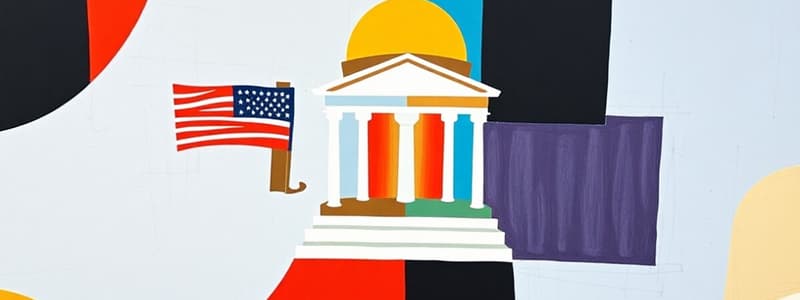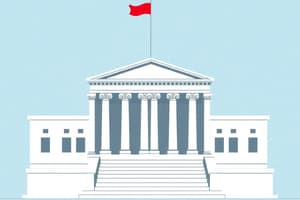Podcast
Questions and Answers
What is the primary purpose of the checks and balances system in the U.S. government?
What is the primary purpose of the checks and balances system in the U.S. government?
- To allow the executive branch to dominate the legislative process
- To streamline legislation and reduce debate time
- To enhance the power of the federal government over the states
- To prevent any single branch from becoming too powerful (correct)
Which of the following accurately describes the amendment process for the U.S. Constitution?
Which of the following accurately describes the amendment process for the U.S. Constitution?
- It is designed to facilitate quick changes to the Constitution
- It necessitates significant supermajorities in both legislative and ratification steps (correct)
- It can be executed solely by the executive branch
- It requires a simple majority vote in Congress only
What principle underlies the system of representation in the American political system?
What principle underlies the system of representation in the American political system?
- Representation is limited to national elections only
- Direct democracy ensures that every citizen votes on all matters
- All citizens hold equal power in legislative decisions
- Representatives are elected to act on behalf of the citizens (correct)
What does the separation of powers principle accomplish in the U.S. government?
What does the separation of powers principle accomplish in the U.S. government?
Which action can the executive branch take to limit the legislative branch's power?
Which action can the executive branch take to limit the legislative branch's power?
What is the primary role of the legislative branch of the U.S. government?
What is the primary role of the legislative branch of the U.S. government?
How many members are there in the U.S. Senate?
How many members are there in the U.S. Senate?
Which of the following is a responsibility of the executive branch?
Which of the following is a responsibility of the executive branch?
When it comes to judicial appointments, who appoints justices to the Supreme Court?
When it comes to judicial appointments, who appoints justices to the Supreme Court?
What is one exclusive power of the federal government?
What is one exclusive power of the federal government?
How long is the term for a member of the House of Representatives?
How long is the term for a member of the House of Representatives?
What principle ensures that no branch of government becomes too powerful?
What principle ensures that no branch of government becomes too powerful?
Which body is responsible for interpreting laws and punishing violators?
Which body is responsible for interpreting laws and punishing violators?
Flashcards
Branches of Government
Branches of Government
The U.S. government is organized with three distinct branches: the legislative, executive, and judicial. Each branch holds specific powers to prevent any one from becoming too influential, helping to maintain a fair balance of power.
Checks and Balances
Checks and Balances
A system where each branch of government can limit the power of the other two branches.
Legislative Branch (Congress)
Legislative Branch (Congress)
The legislative branch, also known as Congress, makes laws. It's composed of two houses: the Senate and the House of Representatives, with specific members and terms for each.
Amending the Constitution
Amending the Constitution
Signup and view all the flashcards
Executive Branch
Executive Branch
Signup and view all the flashcards
System of Representation
System of Representation
Signup and view all the flashcards
Judicial Branch
Judicial Branch
Signup and view all the flashcards
Separation of Powers
Separation of Powers
Signup and view all the flashcards
Supreme Court
Supreme Court
Signup and view all the flashcards
Preventing Tyranny through Checks and Balances
Preventing Tyranny through Checks and Balances
Signup and view all the flashcards
Federalism
Federalism
Signup and view all the flashcards
Federal Power Distribution
Federal Power Distribution
Signup and view all the flashcards
Balance of Power in Federalism
Balance of Power in Federalism
Signup and view all the flashcards
Study Notes
Branches of Government
- The U.S. government is structured with three main branches: the legislative, executive, and judicial.
- These branches are designed to have checks and balances on each other's power, preventing any one branch from becoming too dominant.
- These checks and balances are essential to maintaining a democracy and avoiding tyranny.
The Legislative Branch
- The legislative branch, also known as Congress, is responsible for creating laws.
- It is bicameral, meaning it consists of two houses: the Senate and the House of Representatives.
- The Senate has 100 members, two from each state, with staggered six-year terms.
- The House of Representatives has 435 members, based on the state's population, with two-year terms.
- Congress has significant powers in lawmaking, including the power to declare war, raise and support armies and a navy, and to coin money.
The Executive Branch
- The executive branch is headed by the President of the United States.
- The President is responsible for enforcing laws, commanding the military, and appointing judges.
- The Vice President serves as the President of the Senate and assumes the presidency if the incumbent is unable to fulfill their duties.
- The executive branch includes numerous federal agencies, departments, and bureaus, each responsible for specific tasks in the administration of laws.
The Judicial Branch
- The judicial branch interprets laws and punishes those who violate them.
- The Supreme Court is the highest court in the land and its decisions are binding on all other lower courts.
- It's made up of nine justices, appointed by the President and confirmed by the Senate, and they serve for life.
- The federal courts hear cases involving federal laws, the U.S. Constitution, controversies between states, and other matters.
- The court's decisions shape the understanding and application of the law across the country.
Federalism
- The U.S. government operates under a federal system, meaning power is shared between the national government and state governments.
- Certain powers, such as coining money and declaring war, are exclusively vested in the federal government.
- Other powers are reserved for the states, like power over education and intrastate commerce.
- The Constitution outlines the specific powers granted to each level of government, defining the structure of both federal and state systems.
- This balance of power is crucial in preserving both national unity and local autonomy.
Checks and Balances
- Each branch of government has powers to limit the actions of the other two branches.
- The legislative branch, for instance, can impeach and remove the president or federal judges.
- The executive branch can veto legislation passed by Congress, and the judicial branch can review laws to determine if they are constitutional.
- The system of checks and balances ensures that no single branch becomes too powerful, maintaining balance and preventing abuse of authority. This is a core tenet of American democratic governance.
Amendment Process
- The U.S. Constitution can be amended, meaning added to or altered.
- This process is outlined in the Constitution itself and requires significant supermajorities in both the legislative and ratification stages.
- The process is designed to ensure that changes to the Constitution are carefully considered and widely supported.
- Amendment processes can be complex and time-consuming.
System of Representation
- The principle of representation lies at the heart of the American political system.
- The people elect representatives to act on their behalf in government.
- Different levels of representation exist, from local to national.
- Representation varies in its composition and function under different jurisdictions based on the details of each office.
Separation of Powers
- Power is divided among the legislative, executive, and judicial branches.
- This separation is a fundamental principle of the U.S. government. Each branch has distinct roles and responsibilities.
- The Constitution carefully defines these roles, limiting the power of government through division and preventing tyranny.
Studying That Suits You
Use AI to generate personalized quizzes and flashcards to suit your learning preferences.




